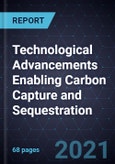Carbon Capture and Sequestration Technologies Drive Deep Decarbonization
Mitigating greenhouse gases is the way ahead to avert catastrophes arising from climate change. Permanently removing greenhouse gas emissions from the atmosphere is a huge and urgent task. Emission reduction technologies are necessary to achieve deep decarbonization in emission-intensive industries and net-zero emissions in the long term. Industry participants are adopting technologies adhering to reduced emissions protocols, along with energy-efficient processes. Among the decarbonization technologies, carbon capture and sequestration (CCS) processes have been identified as the potential game changer to enable stakeholders to achieve carbon neutrality globally. CCS processes are among the most important technological solutions to reduce emissions. The processes involve capturing carbon dioxide from point and non-point sources and permanently injecting and storing it underground.
This research service focuses on CCS technological advancements and the latest trends in the industry. The study highlights the importance of various CCS technologies and discusses major drivers and challenges to CCS technology development in gaining wide-scale market adoption and competitiveness.
The study covers the following:
- Overview of CCS technologies and their technology readiness level
- Technology comparison
- Technology ecosystem and key stakeholders
- Techno-economic analysis of CCS technologies
- Growth opportunities in CCS technologies
Table of Contents
1.0 Strategic Imperatives
1.1 Why Is It Increasingly Difficult to Grow? The Strategic Imperative 8™: Factors Creating Pressure on Growth
1.2 The Strategic Imperative 8™
1.3 The Impact of the Top Three Strategic Imperatives on the Carbon Capture and Sequestration (CCS) Industry
1.4 Growth Opportunities Fuel the Growth Pipeline Engine™
2.0 Research Context and Summary of Findings
2.1 Research Context and Scope
2.2 Key Questions Addressed
2.3 Research Methodology
2.4 Key Findings in CCS Technologies
3.0 CCS Technologies - Overview
3.1 Global Need to Reduce Emissions to Align with Carbon Neutrality Targets
3.2 CCS Technologies for Deep Decarbonization
3.3 CCS Technologies - Technology Maturity Level
3.4 Growth Drivers
3.5 Growth Restraints
3.6 CCS Value Chain
4.0 Carbon Capture Technologies
4.1 Pre-combustion Process Has High Carbon Capture Rate Even from Exhaust Streams with Low Carbon Dioxide Concentration
4.2 Most Commercially Proven Post-combustion Capture Process is Solvent Absorption
4.3 Solvent Absorption Enables High Rate of Carbon Dioxide Capture
4.4 Solid Adsorption Requires Lower Energy for Enhanced Carbon Capture and Solvent Regeneration
4.5 Membrane Separation Selectively Segregates Emissions from the Exhaust Stream
4.6 Direct Air Capture Enables High Recovery of Carbon Dioxide Directly from the Atmosphere
5.0 Carbon Compression, Purification, and Transport Technologies
5.1 Compression and Purification Ensure Captured Carbon Dioxide is Adequate for Transport and Storage
6.0 Carbon Injection and Storage Technologies
6.1 Extensive Development of Carbon Storage and Monitoring Technologies
6.2 Mechanisms Trapping Carbon Dioxide Within the Subsurface of Geological Formations
6.3 Essential Criteria to Evaluate and Select Suitable Storage for Captured Emissions
6.4 Storage Reservoirs - Geological Formations Permanently Store Carbon Dioxide
6.5 Storage Reservoirs - Ocean Storage at Depths Below 1,000 Meters Permanently Store Carbon Dioxide
6.6 Storage Types - Saline Formations are Extensively Used for Carbon Storage
6.7 Storage Types - Global Basalt Reservoirs Will Increase Carbon Storage Volumes in the Future
6.8 Saline and Basalt Formations are Widespread and Abundant
7.0 Innovation Ecosystem - Companies to Watch
7.1 Industrial Lung Based on Enzymatic Technology for Efficient Carbon Capture
7.2 Amine Solvent-based Liquid Absorption Technology for Carbon Capture
7.3 Patented Modular Carbon Capture Systems Enhance Decentralized Emissions Reduction
7.4 Small-scale DAC Facilities Reduce Emissions from Non-point Sources
7.5 Storing Captured Carbon Dioxide Under the Ocean Floor
7.6 Storing Dissolved Carbon Dioxide in Basalt Formations
7.7 Storing Carbon Dioxide in Depleted Oil and Gas Reservoirs
8.0 Regional, Cost, and Patent Analysis
8.1 CCS in the Americas - Several CCS Facilities are in Operation
8.2 CCS in Europe - The European Green Deal is a Milestone for CCS Facilities Deployment
8.3 CCS in Asia-Pacific - Australia and Japan Accelerate CCS Activities
8.4 Existing Operational Storage Sites and Types
8.5 Indicative Costs Analysis for CCS Value Chain Components
8.6 The US Has a Significant Impact on the Patent Landscape in CCS
9.0 Growth Opportunity Universe
9.1 Growth Opportunity 1: Disruptive Technologies Increase Carbon Capture Rate
9.2 Growth Opportunity 2: R&D Investments for a Smooth Low-carbon Economy Transition
9.3 Growth Opportunity 3: R&D Partnerships to Ensure Cost-effective Carbon Sequestration
10.0 Key Contacts
10.1 Key Contacts
11.0 Next Steps
11.1 Your Next Steps
Legal Disclaimer








